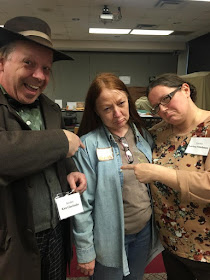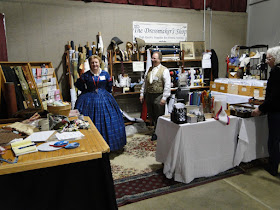 |
| Diligence pays off! |
And she did it very successfully, I might add.
My friend and reenacting "daughter," Kristen, put together a Civil War era conference, and it was a great success, especially considering it was her first time doing something like this.
Heck! It would be considered a great success even if this was her tenth time putting this conference on. Yes, that's how good it was.
When Kris had found out back in early 2016 that the Harrisburg, PA conference would not take place in 2017, she was sorely disappointed, for she, being a teacher and all, loved the educational aspect of these conferences. So, rather than just sit and complain about it, she decided to take things into her own hands and put one together herself.
Well...with a little help from her friends.
Actually, she got a lot of help from one friend in particular: Glenna Jo Christen.
And I know that there were others who were also there for her, but it was she - Kristen - who was the one who spear-headed this entire project; it was she who had a hand in each "pot," stirring up a collection of 1860s goodies for the many who want to continue to learn of the time period and improve their own reenacting impressions.
She had a full list on the itinerary including workshops for aprons and pineapple purses, exhibitions for 1860s wedding dresses in one room and warm weather wear for men in another. There were talks on Pregnancy in the 1850s and 1860s, original Civil War collections, Doll Basics, The Trial of Lincoln Conspirators, The History of Mourning Practices, 19th Century Entertainment, Making Young People Feel Welcome, and, my particular favorite lecture, Bringing the Past to Life.
Of course, there were vendors and historic artifacts exhibits, a fine lunch and dinner (or a fine dinner and supper!), and a Friday evening soiree held at the Historic Sawyer House, where many visitors from the conference wore their 1860s finest.
If a guest was bored, it was their own fault.
So, let's take a pictorial journey interspersed with Kristen's own words (and some of my own) to what we are now calling The First Annual Citizens Forum of the 1860s Conference:
From Kristen: "How can I even begin? We started planning a year ago, wondering about the future of civilian Civil War educational events, as so many have stopped or taken a break. Glenna Jo and I wanted a comfortable place to learn and grow, one where young people could interact with mentors to better the community as a whole. We decided upon Monroe County Community College, with a chance meeting at The Historic Sawyer Homestead that sealed the deal!"
 |
| Here are a few of the lovely ladies who are in the 21st Michigan. They attended the Friday evening soiree. |
 |
| Mrs. Aldridge also looked particularly fashionable while wearing her 1860s finest as she visited inside the Sawyer Home. |
 |
| Glenna Jo & Kristen giving a speech. I believe this was the introductory speech, welcoming everyone to the conference. |
"Bringing the Past to Life."
When Kristen asked me last year if I would be a speaker at her 2017 Citizens Forum of the 1860s Conference, I was surprised. Shocked, even.
Me?
Who am I?
She then explained how my passion for living history - my practice of 1st person and immersion - has had such an affect on other reenactors, not only in the metro-Detroit area but, due to my Passion for the Past blog, to many others across the country, she felt I should speak on the topic to interested guests who are not quite sure what this "bringing the past to life" stuff was all about.
I was honored.
But, I explained to her that it was more than just me; I have an amazing group of willing participants who join me in these time-travel excursions - people of whom I could not do it anywhere near as authentic if they were not there with me.
And Kristen, as part of that amazing group of willing participants, knows this.
So I asked the two people who I work with the closest in this capacity: Larissa and Jackie.
 |
| Bringing the Past to Life: Though most attendees knew the definitions of each type of reenacting stye, there were a few there that were new to the hobby who did not. Now they do! |
*sigh*
Being aware that Victorian mourning is very popular these days, we were a bit nervous and figured we'd be lucky to have five guests in our room.
Were we wrong!
 |
| Look at all the folks who came to hear our little lecture! |
 |
| We
were pleasantly surprised at the amount of guests who came to see us - I believe every chair was taken with a few more brought in! This photo only shows half of our room - - - |
Needless to say, our presentation
went very well - my gosh! The compliments we received!
We were truly honored...
The only thing that would have made
it perfect? If Jackie had her "speaker" badge. Alas, it was
misplaced...
 |
| Poor Jackie. Her "speaker name tag" was nowhere to be found. Obviously, Larissa was more empathetic than I. Here, how's this: "Poor, poor Jackie." Is that better? |
 |
| Taking notes during one of the seminars. |
But I've heard so much positive from those who did attend.
And then there were vendors!
 |
| Michael Mescher, owner of Ragged Soldier Sutlery, had his "store" of 19th century entertainments available for sale. Plus, he had a large supply of chocolate powder made from a colonial recipe. Yeah...I bought a large package... |
 |
| Kim Lynch, proprietor of the Dress Maker's Shop. |
 |
| This gentleman represented Sullivan Press. I have purchased numerous items from Sullivan Press in years passed and have found their product to be of museum quality. |
 |
| Replicated period jewelry for sale... |
 |
| Samantha, proprietor of ReproDolls. She collects originals and then replicates them. What a unique item, eh? |
 |
| Kristen's originals |
 |
| And there were Original dresses from the 1860s, courtesy of Glenna Jo. |
 |
| Enlarged versions of original CDVs owned by Bill Christen were on display. This really gives one the opportunity to see, up close, details that are almost hidden in their original smaller sizes. |
Saturday also found us enjoying a wonderful luncheon and a spectacular chicken dinner.
 |
| I can drink this cranberry juice because it's from 1865! At least, that's what it stated on the wrapper - - Man! Cranberry juice tasted so much better back then... |
Here are just a few of the positive reviews from the survey handed out to the guests:
"Kristen's hair was very pretty
Saturday." (I had to include this one!)
"I like that there was a wide
variety."
"It was fantastic. Great Job.
People were so kind and helpful. I loved it!!"
"Thanks to Kristen and Glenna
Jo for all of their hard work. Overall this conference was good. I will be
returning in the future."
And even pre-teens gave their input, too.
"Paper Dolls!" was one suggestion.
Well, there you have it! My hat is off to Kristen, Glenna Jo, and all who played a part in making the Citizens Forum of the 1860s Conference the success it was. It does take lots of time, effort, time, helpers, time, research, and time.
And guess what?
As I hinted earlier in this posting, this was the first annual....you know what that means, right?
Yup - more's a-comin'! You see, I have inside information: mark your calendar for March 23-25, 2018.
Thank you, Kristen, for all you've done and for allowing Larissa, Jackie, and myself to play a part in your success. As I said, we were honored.
Oh! And thank you to Larissa Fleishman and Elizabeth Aldridge for allowing me to use a few of their pictures along side my own to accent this posting.
I certainly appreciate it!
Until next time, see you in time.
.







































